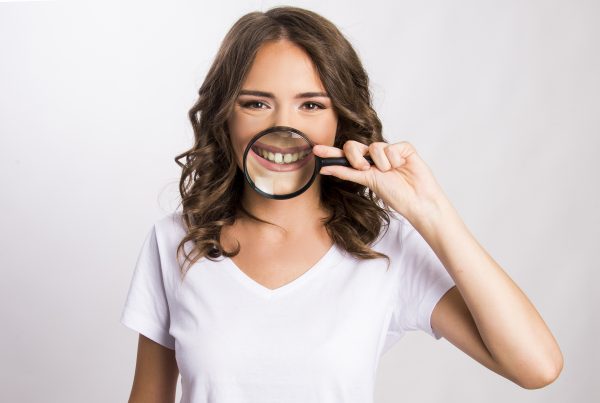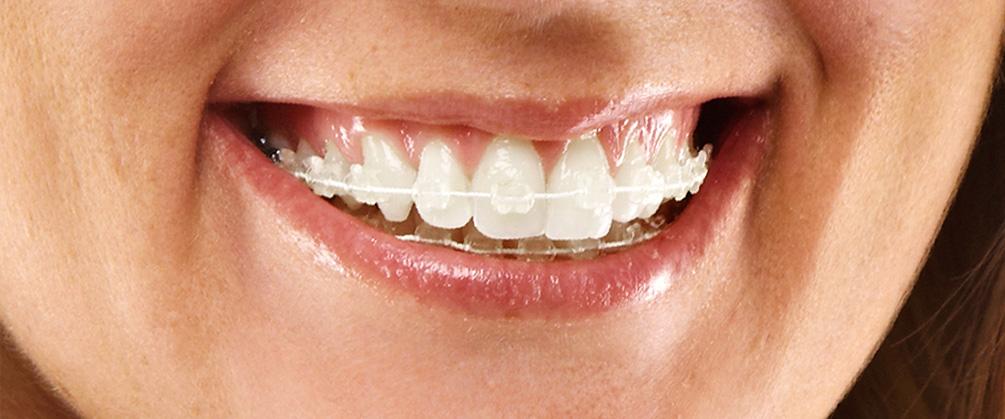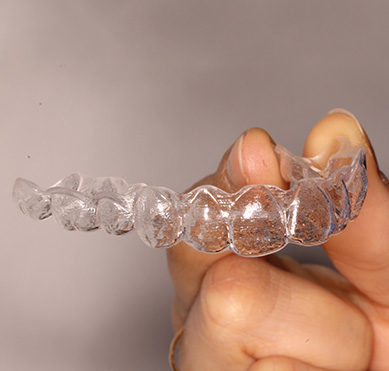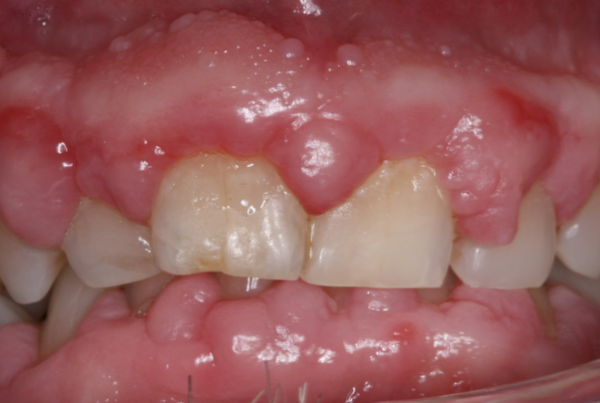Treatment with braces has come a long way over the last few years. Braces no longer have to be the classic metal ‘train track’ style that teenagers get. Now there are some really discrete options that are suitable for adults.
The benefit of this type of treatment is that after treatment with braces, your teeth are still your teeth. They haven’t been drilled away. They aren’t weaker. They are your teeth that have been lined up to give you that confidence to smile and to show them off. If you are unhappy with the straightness of your teeth, braces are the only option.
Once the teeth are lined up, they can be whitened. After that, any uneven bits can either be carefully smoothed or added to with ‘bonding’ to really give that wow factor.
All of these treatments are conservative and considerate to the long term health of the teeth. To my mind, it’s a fantastic way to change your smile.
Let’s go through the different options for straightening your teeth.
Traditional ‘train track’ braces
As I said above, this is the type of thing that most people think of first when you say the ‘braces’. It’s certainly an option and is really effective. These braces work by having little squares called ‘brackets’ stuck to your teeth during the treatment. A wire is placed between the brackets. It’s this wire that carefully pushes and pulls on the teeth to bring them into line.
The downside is that it is probably the least discrete option available. It may be the best option for you if you need very complicated treatment. However, quite often your dentist or specialist will be able to find a more discrete option.
You can sometimes have these train track braces stuck to the inside of your teeth. These are called ‘lingual’ braces. ‘Lingual’ just means tongue so the brace is on the tongue side of your teeth and not on the outside. These can work very well if your dentist is good at them but it is tricky from a dentist point of view.
The great thing about the ‘lingual’ braces is that you can’t see them because they are on the inside of your teeth. They can be quite restrictive and uncomfortable to your tongue.
Clear braces and white wires
This type of brace is like a train track brace but the brackets and wires are tooth coloured or clear. The brackets are still fixed to your teeth while the wires gently bring the teeth into line. The benefit is that they are much less noticeable.
These braces are not invisible. No brace is going to be completely invisible. Up close, your family will be able to see that there is something on your teeth. Lots of other people who wouldn’t get as close will not spot them. They are very discrete at a ‘social distance’, when you have your personal space. When my face is pressed into someone’s armpit tomorrow on a packed train, I have lost that social distance and I’m much more likely to spot their clear braces.
So why would you bother having these white brackets and wires if there are less visible options that I’m going to mention below? The biggest benefit of actually having brackets on your teeth is that they are on your teeth all of the time. That means they are working all of the time. The next two options can be taken out by you. This may be useful if you fancy taking them out to eat for half an hour but if you are taking them out and leaving them out, your treatment will be quite slow or won’t work.
Clear braces and white wires are working 24 hours a day. They will often give you a finished result in a much quicker time than the options of aligners or removable braces.
Aligners
An aligner is a thin, clear, plastic tray that covers your teeth. You have a series of aligners made up that move your teeth in small steps. You swap the aligner every couple of weeks or so.
This type of treatment is probably the least noticeable type of brace you can get. The appliance will be less than a millimetre thick and they are also see through.
You can take them out to eat and to clean your teeth. This is both a good and a bad thing. Other types of brace will make eating much harder and can trap food. Being able to take the aligner out for eating and cleaning is really handy. But if you keep taking them out to eat or do something else and you forget to put them back in, you’re in trouble. If you’re not wearing the brace then it’s not moving your teeth. You need to be wearing the aligners 22 hours a day. If you are leaving them out then the treatment will not work.
That’s why I say it is both a good thing and a bad thing. You are in charge but if you’re not committed to wearing them, aligners are not for you.
This type of brace is usually made by planning out the tooth movements on a computer and then 3D printing the aligners. It’s fantastic technology and also means that the end result is very predictable. The drawback to this is that this technology is not cheap and so this is going to be probably one of the more expensive ways to straighten your teeth.
You can do a lot with this type of brace. In fact, it is possible to treat just about any patient with this method. From my experience, the drawback with aligners is that it just takes longer to get the end result than the options where the braces are fixed to your teeth.
So it’s a bit of a trade off. If you want the most discrete option and don’t mind it taking a bit longer, this may be for you.
Removable braces
Removable braces come in all shapes and sizes. Most commonly, it will be some plastic in the roof of your mouth and a wire along the front of your teeth.
Removable appliances generally work best for more simple treatment. There is a limit as to how much can be done with some of these removable cosmetic systems. However, they can make simple improvements quite quickly and they are usually cheaper than other options.
Again, the same drawback as with aligners applies. If you can take it out and you leave it out, your teeth are not going to get straight. You have to be committed to wearing it!
Treatment by a specialist
A specialist dentist for braces is called an ‘orthodontist’. An orthodontist is a dentist who has gone back to university for another few years to be the absolute boss of making teeth straight. They know all you could want to know and a whole lot more about lining up those sparkly beauties.
An orthodontist can offer all of the different methods mentioned above.
Children and teenagers should always be treated by one of these specialists because they need to be treated ideally. This means not only straightening the front teeth but also moving the back teeth into the ideal bite. Orthodontists are great at creating this ideal bite for kids.
For adults who want to straighten their teeth for cosmetic reasons, the bite is often not so important. If you can eat and chew comfortably at the moment, you may not be that keen to have 2 years of treatment with braces to get the perfect bite; you may be happier to just have your front teeth straightened in a much, much shorter time.
Your focus may be on just improving the front teeth and getting that confidence to smile. If that is the case then it may not be necessary to see a specialist.
Treatment with a specialist will often be more expensive but every practice has different costs and this is not always the case.
If there are some really complex things that you would like to change about your teeth like the position of your back teeth or your bite then you may be better off seeing a specialist. Orthodontists are fantastic for this type of thing because they have that extra training.
The creator of The Online Dentist, Andrew Wilson is the winner of Best Young Dentist in the UK 2017. Andrew (GDC number 209563) practices in Central London. If you would like to know more about Andrew or how he could transform your smile, visit his website or contact him.
Recent Articles
 We all want a beautiful, bright smile. Teeth whitening can be a great way to achieve that. If you whiten your teeth with the help of your dentist, it's a...
We all want a beautiful, bright smile. Teeth whitening can be a great way to achieve that. If you whiten your teeth with the help of your dentist, it's a...
 Lots of people have gaps between teeth. Commonly, this happens between your front teeth but you can have a space between any teeth in your mouth. As I write this...
Lots of people have gaps between teeth. Commonly, this happens between your front teeth but you can have a space between any teeth in your mouth. As I write this...










